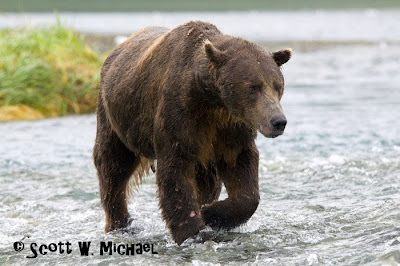One of the big stars of Geographic Bay was a big, heavily scarred male that we called “Al” (as in Al Pacino - Scarface). He appeared to be the dominant bear, as all other bruins in the area gave him wide berth. While we never saw any bears fighting at Geographic, the evidence of some serious combat was obvious.
On one of our last days in Katmai, we observed a large boar with a flap of flesh peeled back from a large, open wound on its hind quarters. Every adult boar had war wounds. In most cases, these were gashes on the forelegs or wounds around the neck. One bear had a gash on its head that almost reached the eye (at first we thought the eye had been damaged). While everything seemed fairly copasetic during our stay, the area was no doubt an arena from some terrific bruin battles.
 A large boar bearing wounds on the forelegs and around the neck - war wounds from intense bruin battling!
A large boar bearing wounds on the forelegs and around the neck - war wounds from intense bruin battling!Grizzly Aggression
Stonorov and Stokes (1972) found that there were four situations in which aggression most often occurs in brown bear aggregations. They were: 1. when one bear moves too close to another bear (invades personal space) 2. when one bear loses a challenge but then redirects its aggression toward a nearby bear (displacement aggression) 3. when two bears compete for a preferred fishing site 4. when two strange bears meet.
Stonorov and Stokes describe what typically happens during an intense, aggressive encounter between two bears that are similar in social ranking. Firstly, the bears confront one another – that is, they face each other with the front legs stiffened, the heads are lowered slightly and all movements are slow and deliberate. Also, the ears are laid back, both have their mouths open to expose their canines (known as a weapons threat) and there is excess saliva production. (Bears often drool when they are stressed.)
One of two things can happen at this point – one of the bears may back down or one or both bears may charge. When charging occurs one or both bears run at each other with their heads lowered and their ears back, with mouths open slightly. If neither bear breaks off the charge and retreats at this point, the bears will come to blows. The bruins may swipe at each other with their fore paws, bite each other (usually on the neck) or lock jaws. In some cases, they bite the neck region and shake their heads violently.
When one bear has had enough, it will drop its head even lower than its opponent and begin to slowly back away (facing the winner of the battle). After putting some distance between it and the dominant combatant, the subordinate may turn and walk or run away. The dominant bear might also turn its back to the other bear and move off while still in close proximity to its opponent. This is an exhibition of winner's supreme confidence - it knows that the beaten bear will not attack again, even when the winner turns his back and makes itself more vulnerable. During combat, there will be lots of vocalizations - this is one thing that differentiates fighting from playing (the latter is a relatively quiet activity).
References:
Stonorov D. and A. W. Stokes. 1972. Social behavior of the Alaska brown bear. Int. Assoc Bear Res. & Mang. 23: 232-242.
© Scott W. Michael



No comments:
Post a Comment